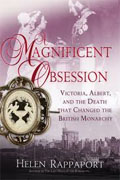A Magnificent Obsession
Helen Rappaport
book reviews:
· general fiction
· chick lit/romance
· sci-fi/fantasy
· graphic novels
· nonfiction
· audio books
· author interviews
· children's books @
curledupkids.com
· DVD reviews @
curledupdvd.com
newsletter
win books
buy online
links
home
for authors
& publishers
for reviewers

 |
A Magnificent Obsession: Victoria, Albert, and the Death That Changed the British Monarchy Helen Rappaport St. Martin's Press Hardcover 352 pages March 2012 |
|
One may never see devotion more true than that which can occur between husband and wife. Some take that devotion to excess, however, living in mourning for decades after their spouses die. Queen Victoria, Great Britain's monarch from 1837-1901, is one such woman. She went so far as to go into virtual seclusion for ten years when her beloved Prince Albert died in 1861. Helen Rappaport studies this period of grief and tragedy for a nation in her book A Magnificent Obsession
This is all covered in the first chapter. The book goes on to follow the slow decline of Albert's health until his eventual death on December 14, 1861. Victoria's penchant for intense grief and refusal to do her queenly duties due to such grief first reared its ugly head when her mother had died a few months before. Rappaport talks about Albert's decline, during which he had to support Victoria, even more than he already had been, through the long months following her mother's death. All of this while he was ailing himself. The ten years after Albert's death were harsh for Victoria; she refused to appear in public at all and only rarely was convinced of the necessity of it. She hid up in a royal box for her son's wedding, for example. The nation grieved with her for a while but eventually wanted to get on with the business of living—something Victoria didn't seem to appreciate. Businesses in London were hurting because there were no royal balls, no state visits from other countries, no official functions put on by the Palace—the bread and butter of some of these industries. Victoria was convinced that the rest of the nation shared her intense mourning despite all evidence to the contrary. It actually became a royal crisis. Many advocated her giving up her throne to her son, something she would never do because she thought him a layabout unfit to be king. Rappaport delivers events in chronological order as the years of the 1860s go by: the political crises; Victoria's insistence on hiding herself away; the emotional relationship with the only man she really trusted after Albert's death, the Scottish Highlander John Brown. Her portrait of Victoria is of a woman completely lost in her grief, one who doesn't believe that she can function without the man she loved in her life. Rappaport posits that had Albert lived, Victoria would most likely have gladly abdicated her throne to him (something I'm not sure the British people would have gone for). Once he died, though, she held onto it ruthlessly. It's not a pretty picture. Unfortunately, it's also not the most interesting one. Rappaport's fairly straightforward style doesn't engage the reader much if the reader isn't already very interested in the subject. I hadn't read very much on Victoria and only knew what has bled into the popular perception of her. While informative, A Magnificent Obsession That's not to say that the book is incomplete. Rappaport covers both Victoria's seclusion and the popular reaction to it. She devotes a chapter at the end to theorizing on what probably killed Albert. He was diagnosed with typhoid fever, but that is widely considered to have been a misdiagnosis. A Magnificent Obsession Originally published on Curled Up With A Good Book at www.curledup.com. © Dave Roy, 2012 |
| Also by Helen Rappaport: |
|
|
|
 Click here to learn more about this month's sponsor! |
|
| fiction · sf/f · comic books · nonfiction · audio newsletter · free book contest · buy books online review index · links · · authors & publishers reviewers |
|
| site by ELBO Computing Resources, Inc. | |
 Rappaport begins with a brief history of Albert and Victoria's marriage in happier times. They married in 1840, begetting twenty years over which Albert assumed more and more responsibility for the royal affairs. This was partially due to Victoria’s sense that he could handle things better than she, but also the fact that she had nine children in the first seventeen years of their marriage. Rappaport documents the hostility that some government ministers felt over this invader from Germany having such influence on British affairs.
Rappaport begins with a brief history of Albert and Victoria's marriage in happier times. They married in 1840, begetting twenty years over which Albert assumed more and more responsibility for the royal affairs. This was partially due to Victoria’s sense that he could handle things better than she, but also the fact that she had nine children in the first seventeen years of their marriage. Rappaport documents the hostility that some government ministers felt over this invader from Germany having such influence on British affairs.